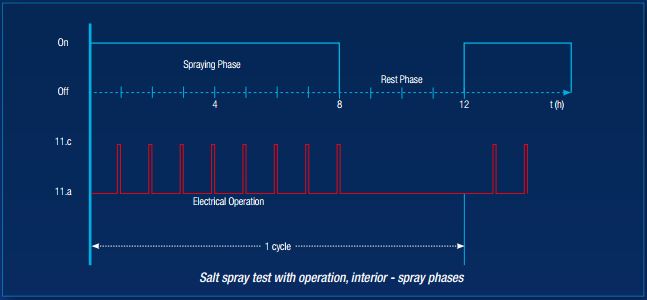In recent years the automotive industry has been faced with many technical challenges in attempting to comply with a series of industrial norms. One of the most important of these norms is LV 124, which was jointly developed by a group of German automobile manufacturers; Daimler Benz, Audi, BMW, Volkswagen, and Porsche.
Most of these manufacturers have now developed their own version of this standard, these include Mercedes (MBN LV 124-1), BMW (GS 95024-2-1), and VW (VW 80000).
This complex 160 page standard covers test procedures for electrical and electronic components in passenger motor vehicles weighing less than 3.5 tonnes, and includes electrical tests, mechanical tests, climatic tests, and service life tests.
Amongst the many individual tests within the standard is a requirement for corrosion testing, this element of LV 124 is based upon EN 60068-2-11, which is undertaken to test the resistance of the component to malfunction when exposed to a salt spray climate at an elevated temperature, due to short circuits and leakage currents caused by ingress of salt into the component.

During the test, specimens are placed in an enclosed chamber and exposed to a continuous indirect spray of neutral (pH 6.5 to 7.2) salt water solution, which falls-out on to the specimens at a rate of 1.0 to 2.0ml/80cm²/hour, in a chamber temperature of +35C. The intermittent salt spray phase is maintained for 8 hours followed by a 4 hour rest period, and hence each cycle lasts for 12 hours.
During the salt spray phase the specimens must be operated electrically under the ‘as installed’ conditions of the component (the components position with covers / trims etc), which needs to be agreed between the tester and the purchaser. If there are several operating modes of the component they must be cycled during the test in proportion to the time spent in that mode during actual operation. Additionally, if the component contains a coolant circuit, the coolant must be set to the test temperature.
For components located on the underbody of the vehicle or within the engine compartment this cycle is repeated 12 times, for all other components it is repeated just 8 times. The tested component must operate correctly before, during and after the test, in relation to a number of defined parameters, which can include; closed-circuit current consumption, operating currents, output voltages, contact resistances, input impedances, and signal rates (rise and fall time).
All Ascott Salt Spray, Cyclic and Atmosfar chambers are able to undertake this element of LV 124, if they are supplied fitted with an entry port to allow the component to be electrically operative during the test.